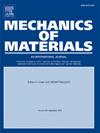动态Eshelby问题:相变缺陷的成核和生长作为深震和破坏波的机制
IF 4.1
3区 材料科学
Q2 MATERIALS SCIENCE, MULTIDISCIPLINARY
引用次数: 0
摘要
将密度相变和模量变化模型为自相似动态膨胀Eshelby椭球体非均匀夹杂的缺陷,在临界载荷高压下可以成核生长。自相似膨胀椭球具有“空洞”性质,粒子速度在内部域消失,这使得恒应力Eshelby性质在内部有效,并且包体在惯性存在下作为一个整体生长。成核和生长的能量学由能量动量张量和第一原理导出,并在惯性存在的情况下推广了Eshelby基于思想实验在静力学中得到的“界面上的力”。解得到了能量在非均匀夹杂物移动相边界上的流动,在其平衡处,对应于M积分的消失,界面不存在障碍,任意小的相变夹杂物在恒定势能下成核生长。该解决方案解释了深震源地震中剪切震源辐射的产生和利马玻璃在压缩下产生微断裂带的破坏波的产生,在非晶化缺陷、合金缺陷、激光增材制造等方面有更广泛的应用。本文章由计算机程序翻译,如有差异,请以英文原文为准。
The dynamic Eshelby problem: nucleation and growth of a phase change defect as the mechanism of deep earthquakes and failure waves
A defect of phase change in density and change in moduli modeled as a self-similarly dynamically expanding Eshelby ellipsoidal inhomogeneous inclusion can nucleate and grow under high pressure at a critical loading. The self-similarly expanding ellipsoid possesses the “lacuna” property, the particle velocity vanishing in the interior domain, which allows the constant stress Eshelby property to be valid in the interior and the inclusion to grow as a whole in the presence of inertia. The energetics for nucleation and growth are derived from the energy-momentum tensor and first principles and generalize in the presence of inertia the “force on an interface” obtained in statics by Eshelby based on a thought experiment. The solution obtains the flow of energies across the moving phase boundary of an inhomogeneous inclusion, at the balancing of which, corresponding to the vanishing of the M integral, the interface presents no obstacle, and an arbitrarily small inclusion of phase change nucleates and grows at constant potential energy. The solution explains the generation of a shear seismic source radiation in deep-focus earthquakes and the generation of failure waves producing a zone with micro-fractures under compression in lima glass, and has wider applications to amorphization defects, defects in alloys, laser additive manufacturing, etc.
求助全文
通过发布文献求助,成功后即可免费获取论文全文。
去求助
来源期刊

Mechanics of Materials
工程技术-材料科学:综合
CiteScore
7.60
自引率
5.10%
发文量
243
审稿时长
46 days
期刊介绍:
Mechanics of Materials is a forum for original scientific research on the flow, fracture, and general constitutive behavior of geophysical, geotechnical and technological materials, with balanced coverage of advanced technological and natural materials, with balanced coverage of theoretical, experimental, and field investigations. Of special concern are macroscopic predictions based on microscopic models, identification of microscopic structures from limited overall macroscopic data, experimental and field results that lead to fundamental understanding of the behavior of materials, and coordinated experimental and analytical investigations that culminate in theories with predictive quality.
 求助内容:
求助内容: 应助结果提醒方式:
应助结果提醒方式:


